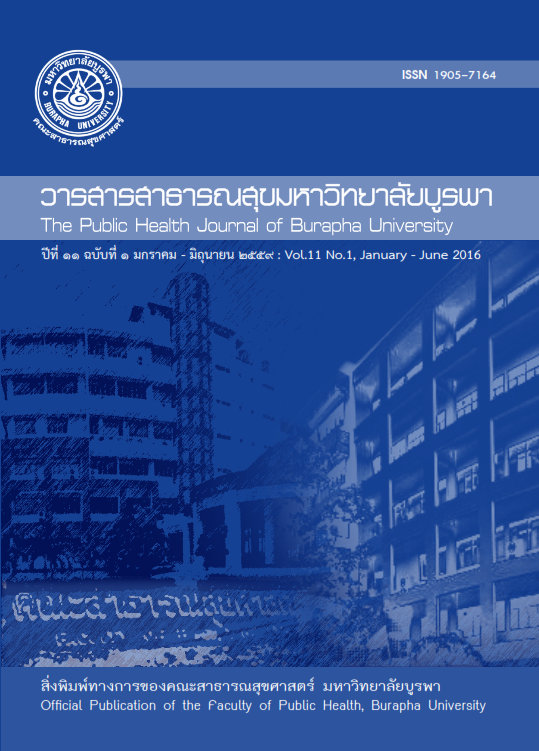Impact of Abortion to Philippine Fertility: A Health and Demographic Perspective
Main Article Content
บทคัดย่อ
The Philippines’ total fertility rate has been analyzed using Bongaarts’ model of proximate determinants using the National Demographic and Health Surveys over the years since the said data had been available. There had been a substantial tracing of societal development supplemented by this.
It had demonstrated the relative contribution of most of the components namely marriage, contraception, postpartum infecundability. The abortion component of the model had been overlooked due to the assumption that it was estimated at the value of ‘1’ referring to the total absence of abortion in the country since it is illegal. With this said, there had been a noticeable continuous increase in disparity of the estimated TFR based on the model and the observed TFR. It is exemplified by the figures from 1993, 1998, 2003, and 2008 contention in this paper is that because of the growing prevalence of abortion in the Philippines, this disparity may be decreased if abortion is given an estimate more fit. Results from preliminary estimates based on independent surveys show that it indeed becomes smaller and maintains this in a stable manner. Together with this, decomposition is done to reassess the relative contribution of each index to the percent change in TFR over the years. Outcomes show it retained the leveling of previous decomposition values but now has accommodated a meaningful segment to abortion. What this entails is that there may be a need for estimations based on various sources to have a more comprehensive view of fertility in the country.
Article Details
เอกสารอ้างอิง
2. Reyes M. Abortion in the current health and health education systems: problems and possibilities. Paper presented at the annual meeting of the Scarlet Letter Network; 2003; Quezon City, Philippines.
3. Bongaarts J. A framework for analyzing proximate determinants of fertility. Popul Dev Rev, 1978; 4(1): 105-132.
4. Bongaarts J, Potter R. Fertility, biology, and behavior: An analysis of the proximate determinants. New York: Academic Press; 1983
5. Cruz C. Philippine fertility transition: Application of the Bongaarts’ model [MA thesis]. University of the Philippines-Diliman; 2008.
6. Stover J. Revising the proximate determinants of fertility framework: What have we learned in the past twenty years?. Stud Fam Plann, 1998; 29(3): 255-297.
7. Cutright P, Smith H. Intermediate determinants of racial differences in 1980 U.S. nonmarital fertility rates. Fam Plann Persp, 1988; 20(3): 119-123.
8. Flavier J, Chen C. Induced abortion in rural villages of Cavite, the Philippines: Knowledge, attitude, and practice. Stud Fam Plann, 1980; 11: 65-70.
9. Singh S, Cabigon J, Hossain A, Kamal H, Perez A. Estimating the level of abortion in the Philippines and Bangladesh. Int Fam Plann Persp, 1994; 23: 100-107.
10. Cabigon J. Abortion and contraception: Their role in explaining Philippine fertility change. In: Capuno J, Orbeta A, editors. Human capital and development in the Philippines: A festchrift in honor of Alejandro N. Herrin. Philippine Institute for Development Studies; 2008.
11. Go E, Palmore J, Tabije T, Reolalas A. Regional variations in Philippine fertility: An exposure analysis for 1993. National Statistics Office and Program on Population, East-West Center; 1995.
12. Kabamalan M. New path to marriage: The significance of increasing cohabitation in the Philippines. Philippine Population Review, 1004; 3(1): 111-129.
13. Natividad J, Marquez M. Sexual risk behaviours. In: Raymundo C, Cruz G, editors. Youth sex risk behaviours in the Philippines: A report on a nationwide study 2002 Young Adult Fertility Survey- YAFS3. Demographic Research and Development Foundation and University of the Philippines Population Institute; 2004.
14. Raymundo C, Cruz G. Youth sex risk behaviours in the Philippines: A report on a nationwide study 2002 Young Adult Fertility Survey- YAFS3. Demographic Research and Development Foundation and University of the Philippines Population Institute; 2004.
15. Casterline J, Domingo L, Zablan Z. Trends in fertility in the Philippines: An integrated analysis of four surveys. Population Council; 1988.
16. National Economic Development Authority. Medium-term Philippine development plan, 2004-2010. Manila; 2004.
17. Costello MP, Casterline J. Fertility decline in the Philippines: Current status, future prospects. In: Population Division, editor. Completing the fertility transition. Department of Economic and Social Affairs, United Nations; 2002.
18. National Economic Development Authority. Update on the medium-term Philippine development plan, 2004-2010. Manila; 2009.

